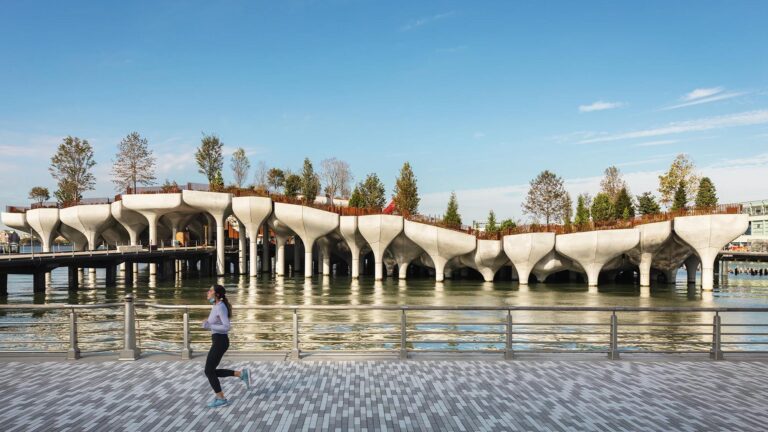Little Island: A Revolutionary Urban Oasis on New York’s Hudson River
Reimagining Waterfront Spaces Through Cutting-Edge Design and Engineering
Perched gracefully above the Hudson River in New York City, Little Island exemplifies a groundbreaking fusion of architectural innovation and environmental harmony. Conceived and engineered by the renowned global firm Arup, this public park captivates with its distinctive tulip-shaped concrete supports that elevate a verdant landscape above the water. Since its inauguration, Little Island has emerged as a dynamic urban sanctuary, transforming a once-overlooked stretch of waterfront into a thriving communal destination. This article delves into the visionary design principles, engineering breakthroughs, and collaborative efforts that brought this exceptional project to fruition.
Structural Ingenuity: The Art and Science Behind Little Island’s Foundation
At the core of Little Island’s striking presence is an inventive structural system that marries artistic form with engineering precision. The park’s signature “tulip” piles—each uniquely sculpted and strategically positioned—serve as robust columns supporting an undulating terrain above the river’s surface. This approach not only overcomes the inherent challenges of constructing over water but also creates a dynamic topography with varied elevations and open spaces that blend seamlessly with the natural environment.
These custom-fabricated concrete and steel piles were engineered to endure harsh environmental conditions, including tidal shifts and severe weather events, ensuring the park’s durability for decades. The design also prioritizes ecological sensitivity,integrating lush plantings and meandering pathways that offer visitors a tranquil retreat within Manhattan’s bustling urban fabric.
- Tailored Fabrication: Each pile was individually cast to meet precise design and load-bearing requirements.
- Eco-Friendly Materials: Selection of sustainable resources minimized environmental impact.
- Modular Assembly: Streamlined construction methods preserved the park’s fluid aesthetic.
| Component | Material | Purpose |
|---|---|---|
| Tulip-Shaped Piles | Concrete & Steel | Structural Support & Foundation |
| Decking | Wood & Composite Materials | Pedestrian Pathways |
| Planting Beds | Specialized Soil Mixes | Flora Cultivation & Ecosystem Balance |
Championing Sustainability: Environmental Stewardship at Little Island
The project team behind Little Island has embedded sustainability at every stage, striving to reduce ecological impact while fostering urban biodiversity. By utilizing materials sourced locally and applying regenerative landscaping techniques, the park supports native flora and fauna, creating a resilient green space that thrives within the city’s ecosystem. The choice of indigenous plants reduces irrigation needs and provides vital habitats for pollinators and birds.
Permeable surfaces throughout the park enhance rainwater infiltration, mitigating runoff and replenishing groundwater reserves.Energy-efficient solar lighting further diminishes the park’s carbon footprint, while rigorous waste management during construction ensured that over 75% of materials were recycled or repurposed.
- Solar-Powered Illumination: Reduces reliance on fossil fuels and lowers emissions.
- Waste Minimization: Construction practices prioritized recycling and reuse.
- Advanced Steel Engineering: Optimizes material use without compromising strength.
- Ongoing Environmental Monitoring: Ensures ecosystem health and adaptive management.
| Initiative | Environmental Effect | Community Benefit |
|---|---|---|
| Native Vegetation | Boosts biodiversity | Supports local wildlife and pollinators |
| Permeable Walkways | Enhances water absorption | Reduces urban flooding risk |
| Solar Lighting | Decreases energy consumption | Minimizes carbon emissions |
| Material Recycling | Limits landfill waste | Encourages circular economy practices |
Fostering Community Connection Through Cultural Engagement
Little Island transcends the customary park model by embedding vibrant cultural programming that invites diverse communities to gather, celebrate, and learn. Arup’s collaboration with local artists and organizations has cultivated a space where creativity and inclusivity flourish. The park regularly hosts a variety of events—from theatrical performances and music concerts to interactive workshops and family-friendly activities—making it a lively cultural hub throughout the year.
This inclusive approach nurtures a strong sense of community identity and pride, encouraging participation across all age groups and backgrounds.
- Community-Driven Curation: Partnerships with local creatives ensure programming reflects neighborhood heritage.
- Seasonal Celebrations: Festivals and pop-up events maintain year-round engagement.
- Interactive Art Installations: Designed to captivate and involve visitors of all ages.
- Educational Outreach: Programs tailored for schools and underserved populations expand cultural access.
| Event Type | Frequency | Audience |
|---|---|---|
| Live Shows | Weekly | General Public |
| Workshops | Monthly | Families & Youth |
| Festivals | Seasonal | Multicultural Communities |
| Educational Sessions | Quarterly | Schools & Nonprofits |
Innovative Maintenance and Enhancing Visitor Experiences for the Future
Looking ahead, Arup is implementing advanced maintenance strategies that utilize real-time data and predictive analytics to preserve Little Island’s structural integrity and ecological vitality. Embedded sensor networks continuously track environmental conditions and infrastructure health, enabling proactive upkeep that prevents deterioration and extends the park’s lifespan.
Simultaneously, visitor engagement is being elevated through immersive digital technologies. Augmented reality tours, AI-powered event suggestions, and interactive wayfinding apps will enrich the visitor journey, blending education with entertainment in novel ways.
- Smart Seating Areas: Equipped with adaptive comfort features and device charging capabilities.
- Real-Time Event Updates: Personalized notifications tailored to visitor interests.
- Eco-Friendly Amenities: Emphasizing sustainability through reusable materials and waste tracking systems.
| Innovation | Advantage |
|---|---|
| Predictive Maintenance Sensors | Early detection of structural issues |
| Augmented Reality Guides | Enhanced visitor interaction |
| Smart Seating | Improved comfort and convenience |
| Dynamic Programming | Customized visitor experiences |
Final Thoughts: Little Island as a Beacon of Sustainable Urban Innovation
Little Island stands as a landmark achievement in urban design, reflecting Arup’s mastery in blending resilience, sustainability, and aesthetic appeal. This innovative park not only redefines the waterfront experience in New York City but also exemplifies how interdisciplinary collaboration can revitalize public spaces.By harmonizing nature, art, and engineering excellence, Little Island continues to inspire visitors and set a benchmark for future sustainable urban developments worldwide.



